
There is a degree of uniformity in the appearance of the headstones at Jewish Gilroes, particularly in the more recent ones. Almost all of those after the Second World War are of white marble with a mixture of Hebrew and English phrases. It is only in the oldest section that greater variety can be seen. Here there are headstones made of a variety of stone, although the slate headstones seen in the non-Jewish sections are noticeably absent.
Flower and Ivy decorations
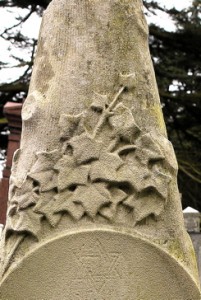
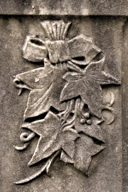 The decoration of the earliest stones was very similar to that seen elsewhere in the cemetery and they were possibly produced by the same masons using the same pattern books. Today, the more ornate embellishments are not in line with Orthodox Jewish practices.
The decoration of the earliest stones was very similar to that seen elsewhere in the cemetery and they were possibly produced by the same masons using the same pattern books. Today, the more ornate embellishments are not in line with Orthodox Jewish practices.
In the early 1900s a limited range of floral carving was used, usually wreaths and sprays of ivy, flowers or foliage. These were either across the top of the headstone forming an arch or as twin pillars framing the inscription. As an evergreen, ivy is a symbol of immortality and is a pictorial form of the traditional Hebrew phrase relating to eternal life, found on the majority of the headstones.
The Tree of Life
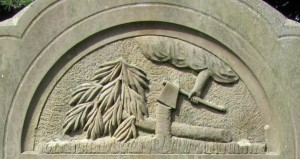
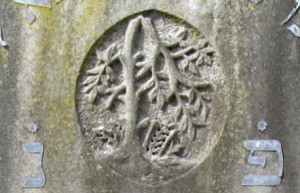
Another symbol that occurs in the older part of the cemetery is that of a broken or cut down tree to represent a life cut short. This is perhaps a reference to the ’tree of life’, mentioned in Genesis, and may be regarded as appropriate in some Jewish burial grounds.
Masonic Symbols
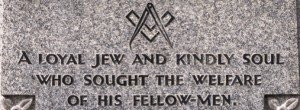 Jewish masonic lodges flourished in the late nineteenth and twentieth century with aims similar to other masonic institutions, those of assisting needy members of the community. A square and a set of compasses was a commonly used masonic symbol and they can be seen carved into one headstone in the old section dating to 1943. Another stone would not in itself be recognized as masonic; the inscription – He lived respected and died regretted – echoes a phrase of masonic ritual and it bears on the stone a sprig of acacia – another masonic indicator.
Jewish masonic lodges flourished in the late nineteenth and twentieth century with aims similar to other masonic institutions, those of assisting needy members of the community. A square and a set of compasses was a commonly used masonic symbol and they can be seen carved into one headstone in the old section dating to 1943. Another stone would not in itself be recognized as masonic; the inscription – He lived respected and died regretted – echoes a phrase of masonic ritual and it bears on the stone a sprig of acacia – another masonic indicator.
There were also other, non-masonic societies, primarily intended as benefit societies. These were often nationally based with local branches. One such branch in Leicester was named in honour of a distinguished Leicester Jewish businessman, and there is an early burial, in 1912 which bears an inscription from the ‘brethren of the Order Achei Brith Sir Israel Hart Lodge No. 36 of whose society the deceased was an esteemed member.
War Grave
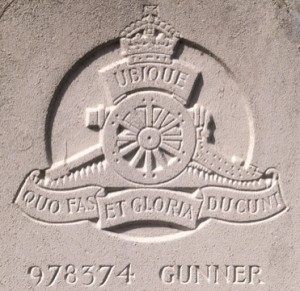 A single military headstone has been erected by the Commonwealth War Graves Commission with the crest of the Royal Artillery at the top above the name and details of the soldier who died in 1941. A Star of David enclosing the five initial letters of the traditional Hebrew phrase (Samuel 25, 29 ‘the soul shall be bound in the bundle of life’) replaces the cross. A second military death is commemorated in the same section and, unusually, contains a Latin inscription. It is on a headstone to the memory of a young airman who died in 1918 and it quotes the line Dulce et decorum est pro patria mori. (It is sweet and fitting to die for one’s country). This sentiment, originally in support of war, was the title of Wilfred Owen’s bitter anti-war poem written in 1917 and published two years after the airman’s death.
A single military headstone has been erected by the Commonwealth War Graves Commission with the crest of the Royal Artillery at the top above the name and details of the soldier who died in 1941. A Star of David enclosing the five initial letters of the traditional Hebrew phrase (Samuel 25, 29 ‘the soul shall be bound in the bundle of life’) replaces the cross. A second military death is commemorated in the same section and, unusually, contains a Latin inscription. It is on a headstone to the memory of a young airman who died in 1918 and it quotes the line Dulce et decorum est pro patria mori. (It is sweet and fitting to die for one’s country). This sentiment, originally in support of war, was the title of Wilfred Owen’s bitter anti-war poem written in 1917 and published two years after the airman’s death.
Star of David
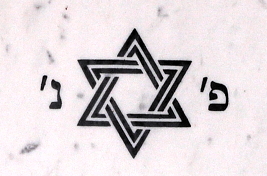 Perhaps surprisingly, the Star of David as a headstone decoration was not automatically used. It is most commonly seen on headstones erected since 1938, possibly reflecting an increased awareness of persecution in Europe due to the arrival in Leicester of refugees from there. As time passed and the community became more established, the headstones in the Jewish burial grounds became less like those in the other sections and the restrained uniformity of the black-lettered, white headstone became the norm.
Perhaps surprisingly, the Star of David as a headstone decoration was not automatically used. It is most commonly seen on headstones erected since 1938, possibly reflecting an increased awareness of persecution in Europe due to the arrival in Leicester of refugees from there. As time passed and the community became more established, the headstones in the Jewish burial grounds became less like those in the other sections and the restrained uniformity of the black-lettered, white headstone became the norm.
 Print This Page
Print This Page